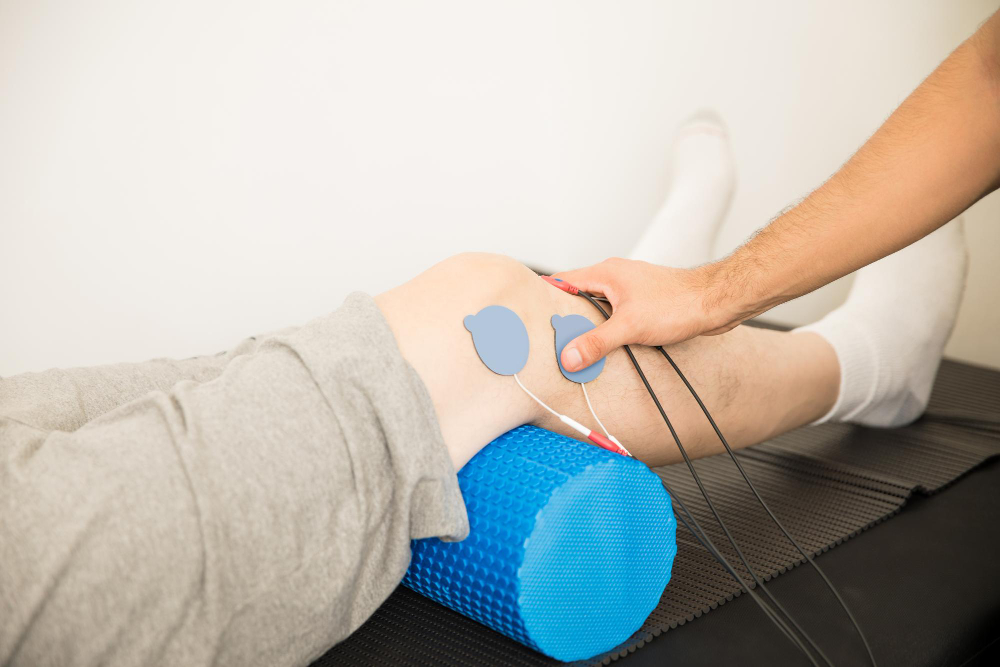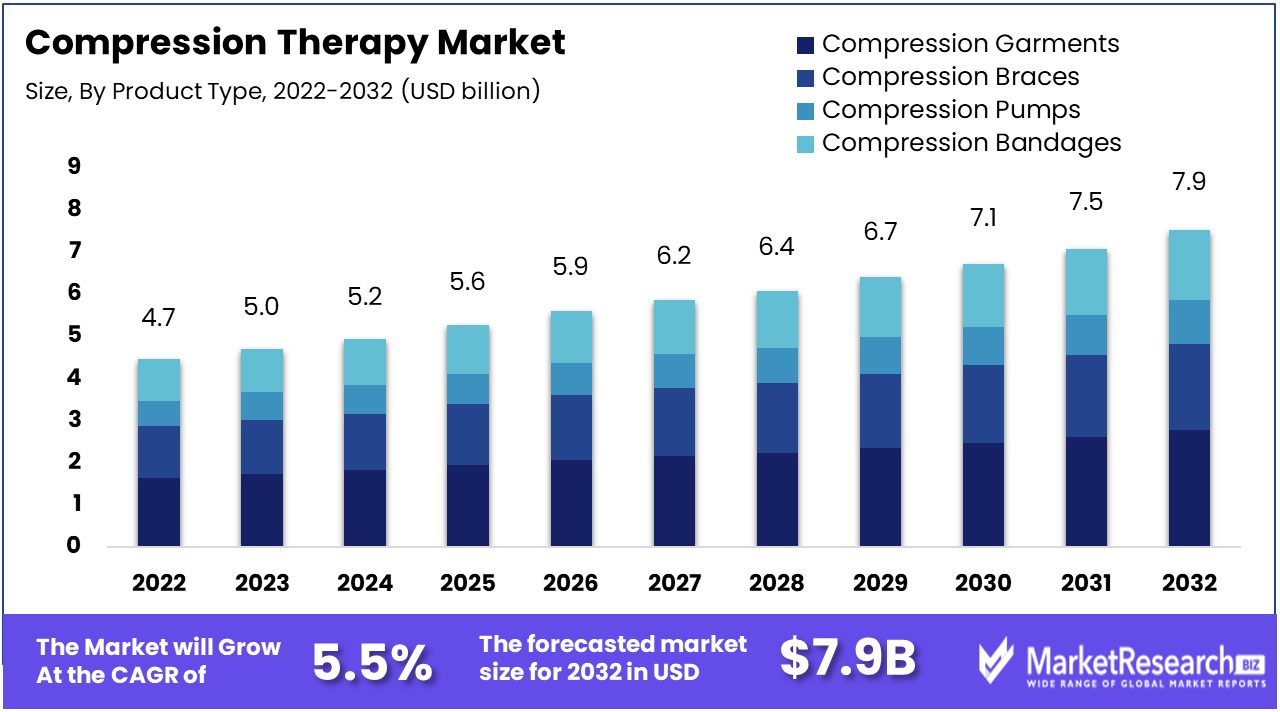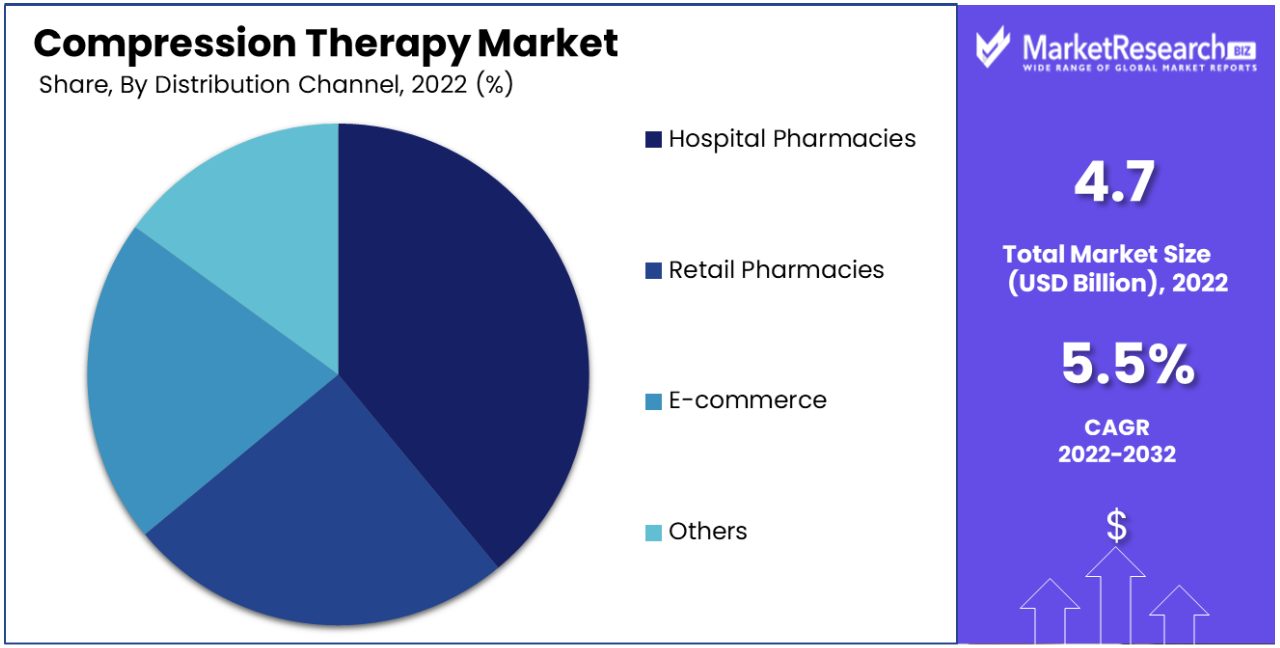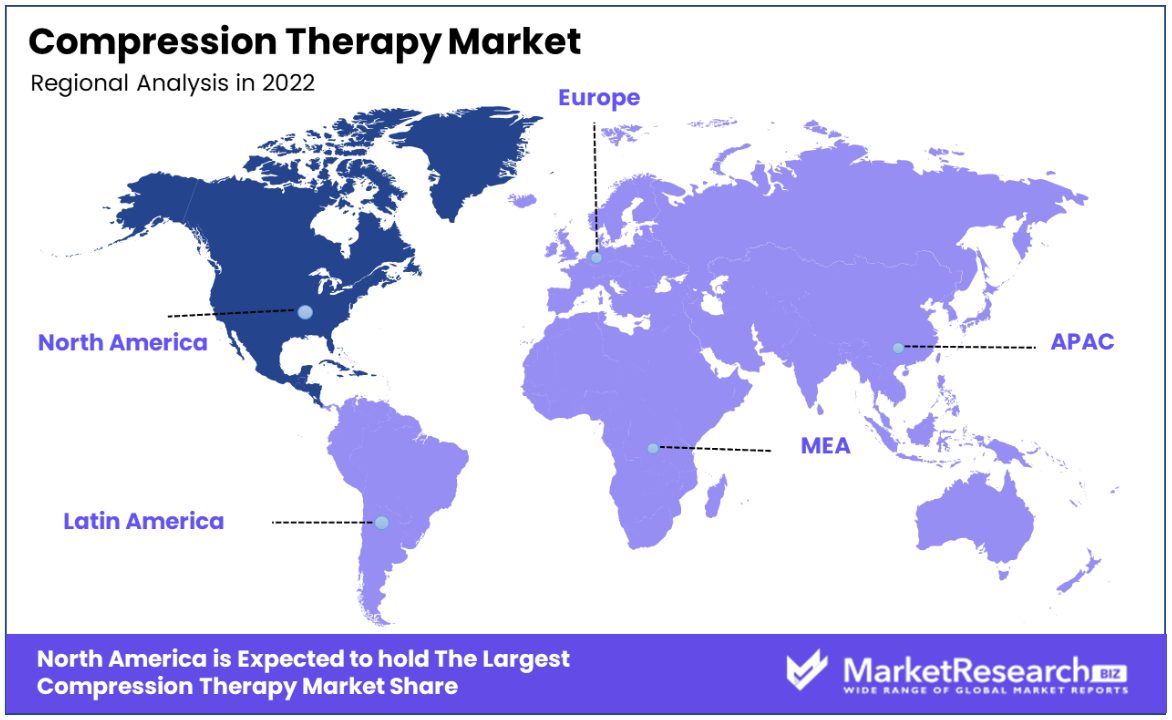
Compression Therapy Market By Product Type (Compression Garments, Compression Braces, Compression Pumps, Compression Bandages), By Distribution Channel (Hospital Pharmacies, Retail Pharmacies, Others), By Technology (Static Compression Therapy, Dynamic Compression Therapy), By Application (Venous Leg Ulcer, Lymphedema, Others), By End User, By Region And Companies - Industry Segment Outlook, Market Assessment, Competition Scenario, Trends, And Forecast 2032
-
3338
-
May 2023
-
165
-
-
This report was compiled by Correspondence Linkedin | Detailed Market research Methodology Our methodology involves a mix of primary research, including interviews with leading mental health experts, and secondary research from reputable medical journals and databases. View Detailed Methodology Page
-
Compression Therapy Market size is expected to be worth around USD 7.9 Bn by 2032 from USD 4.7 Bn in 2022, growing at a CAGR of 5.5% during the forecast period from 2023 to 2032.

The increase in sports related injuries, chronic venous insufficiency (CVI) among individuals and the sudden change in the treatment facilities from clinic and hospitals to home based treatment. Compression therapy devices are basically used to enhance the process of healing and speed recovery of the patients. Products such as stocking, gloves, sleeves and bandages are used frequently to treat the aforementioned medical disorders, thus helping in expanding the market growth.
Some of the advantages associated with the application of compression therapy products in the treatment of specific disorders like venous reflux, decrease of leg and foot volume and hypertension that impels the market growth. Furthermore, the availability of several substitutes starting from bandages and stockings to pneumatic devices to get an effective treatment for several conditions.
Additionally, the rise in compression garments in sports related medicines is expected to offer an exceptional market expansion. Compression therapy is being widely used to prevent swelling like injury and inflammation. Such products are highly used to enhance the blood circulation and avoid coagulation of liquids in the tissue space, thus improving muscle health.
A 2022 study published in the Journal of Vascular Surgery found that compression therapy was effective in reducing symptoms of CVI, such as swelling and pain. Another study, published in the Journal of the American College of Surgeons, found that compression therapy was effective in preventing DVT after surgery.
Moreover, Static therapy devices are gaining popularity due to its cost-effectiveness, wide availability and ease to use which impels the market growth. Likewise, patients can use these devices while working, which is projected to surge in demand for sports persons like the athletes and fitness instructors.
For example, in hospitals and clinics, patients are under the recovery process from a head injury or leg fracture. Doctors or physicians use the static therapy device to provide quick recovery, stability and immobilization to the affected areas in order for proper healing. When the static therapy device gets combined with the compression therapy it provides more additional benefits such as enhancement in blood circulation, reduces swelling and improves the overall therapeutic results.
Likewise, dynamic technology will also witness a significant growth during the forecasted period as a result of many advantages associated leading to the exceptional market growth in future.
Driving Factors
Higher Adoption of Compression Therapy Products Drives Market Growth
The higher adoption of compression therapy products is a fundamental driver for the expansion of the compression therapy market. This trend is rooted in the growing recognition of the effectiveness of compression therapy in managing various medical conditions, such as venous ulcers, lymphedema, and deep vein thrombosis. As healthcare professionals and patients increasingly acknowledge the benefits of compression therapy for both treatment and preventive care, the demand for these products has risen substantially. In this domain, treating vascular ulcers stands out as a key focus, bringing advanced solutions to boost healing and overall market progress.
This increasing adoption is facilitated by the availability of a wide range of compression therapy products, including stockings, bandages, and pumps, which cater to diverse patient needs and preferences. The trend towards home healthcare and self-management of chronic conditions has also contributed to the growing use of compression therapy products.
The long-term implication of this trend suggests sustained market growth, driven by the ongoing acceptance and integration of compression therapy in standard treatment protocols. There is also potential for continued product innovation, focusing on comfort, ease of use, and efficacy, to further enhance user adoption.
Increasing Hospitalizations Necessitate Compression Therapy
The rise in the hospitalization rate, particularly for conditions requiring vascular and wound care management, significantly boosts the compression therapy market. As the number of patients hospitalized with venous disorders, diabetic ulcers, and post-surgical recovery increases, the demand for compression therapy products in clinical settings escalates. Hospitals and clinics are major end-users of compression therapy products, utilizing them for both inpatient treatment and post-discharge care.
The growing aging population and the prevalence of lifestyle-related health issues contribute to the rising hospitalization rates, thereby influencing the demand for compression therapy. In hospital settings, the need for effective, easy-to-use, and quick-to-apply compression solutions is crucial, driving innovation and adoption in the market.
This trend is likely to continue, with the aging population and increasing prevalence of chronic diseases necessitating sustained demand for compression therapy products in healthcare settings.
R&D Fuels Advanced Compression Therapy Market
High investment in research and development is catalyzing the growth of the compression therapy market. Manufacturers and healthcare companies are investing in R&D to develop more effective, user-friendly, and innovative compression therapy products. This includes the integration of advanced materials, smart technologies, and ergonomic designs to enhance the efficacy and comfort of compression products.
Such innovations are aimed at addressing the limitations of traditional compression therapy products, such as issues with patient compliance and difficulty in application. The development of smart compression devices, which can monitor pressure and adjust therapy accordingly, is an example of how R&D is transforming the market.
Rising Venous Conditions Propel Compression Therapy Need
The growing incidence of venous ulcers and other vein diseases across the world is expanding the compression therapy market. Venous disorders, including varicose veins and chronic venous insufficiency, are becoming increasingly common due to factors such as aging populations, sedentary lifestyles, and obesity. These conditions often require long-term management, for which compression therapy is a key component.
As the prevalence of these venous conditions rises, so does the demand for effective management solutions. Compression therapy is widely recognized as a primary treatment modality for these conditions, helping to alleviate symptoms, promote healing, and prevent recurrence.
Awareness of Advanced Compression Devices Drives Market Growth
The rise in awareness related to advanced device options in compression therapy is stimulating market growth. Patients and healthcare providers are becoming more informed about the various types of compression therapy products available, including advanced options like intermittent pneumatic compression devices and smart compression systems.
Educational initiatives by manufacturers, healthcare institutions, and patient advocacy groups have played a crucial role in this increased awareness. As patients and clinicians become more knowledgeable about the benefits and applications of different compression therapy products, the demand for advanced, specialized devices grows.
Restraining Factors
High Cost of Compression Therapy Products Restrains Market Growth
The high cost of compression therapy products, such as advanced compression bandages and pneumatic compression devices, limits their accessibility and adoption, particularly among patients with limited financial resources. These costs can be prohibitive, discouraging individuals from opting for compression therapy even when medically recommended.
The high price point often results from the cost of materials, design sophistication, and technology integration in these products, which can significantly impact the purchasing decisions of both healthcare providers and patients, thus restraining market growth.
Availability of Alternative Treatment Procedures Restrains Market Growth
The presence of alternative treatment procedures for conditions typically addressed by compression therapy, such as deep vein thrombosis and lymphedema, can limit the market growth.
Treatments like medication, surgical interventions, and other non-compression based therapies provide options for patients and healthcare providers. These alternatives might be preferred due to various factors including efficacy, patient comfort, or familiarity by healthcare providers, thereby impacting the demand for compression therapy products.
Compression Therapy Market Segment Analysis
By Product Type Analysis
Compression garments lead the product type segment in the compression therapy market. Their widespread use is attributed to their effectiveness in managing conditions like venous leg ulcers and lymphedema. Garments such as stockings and sleeves are preferred for their ease of use, comfort, and efficacy in improving blood circulation. The growth in this segment is bolstered by the rising prevalence of chronic venous disorders and an aging population.
Compression braces are essential for musculoskeletal injuries, providing support and stability. Compression pumps are increasingly used in managing severe lymphedema. Compression bandages are commonly used in wound care, particularly in treating venous ulcers, due to their flexibility and adaptability to different body parts.
By Distribution Channel Analysis
Hospital pharmacies dominate the distribution channel for compression therapy products. Their proximity to the point of care and the ability to offer patient-specific advice and fitting services contribute to their leading position.
Retail pharmacies are crucial for patient access post-discharge. E-commerce is growing rapidly, offering convenience and a broader product range. Other channels include specialty clinics and online medical stores.

By Technology Analysis
Static compression therapy is widely used due to its simplicity and effectiveness in treating conditions like venous insufficiency and lymphedema. Static compression garments and bandages are preferred for continuous pressure application, making them ideal for everyday use.
Dynamic compression therapy, though less common, is gaining traction for its ability to provide intermittent pressure, beneficial in certain medical conditions and for patients who cannot tolerate static compression.
By Application Analysis
Venous leg ulcers are a major application area for compression therapy. The effectiveness of compression garments and bandages in healing ulcers and preventing recurrence drives their use in this segment.
Compression therapy is also vital in managing deep vein thrombosis and lymphedema. Other applications include recovery from sports injuries and prevention of blood clots in immobile patients.
By End User Analysis
Hospitals and clinics are the primary end users of compression therapy products. They play a crucial role in the initial diagnosis, treatment planning, and follow-up care, making them central to the compression therapy market.
Nursing care centers use compression therapy for elderly and bedridden patients, while home care settings are increasingly adopting these therapies for long-term care. Other settings include rehabilitation centers and sports clinics.
Key Market Segments
By Product Type
- Compression Garments
- Compression Braces
- Compression Pumps
- Compression Bandages
By Distribution Channel
- Hospital Pharmacies
- Retail Pharmacies
- E-commerce
- Others
By Technology
- Static Compression Therapy
- Dynamic Compression Therapy
By Application
- Venous Leg Ulcer
- Deep Vein Thrombosis
- Lymphedema
- Others
By End User
- Hospitals & Clinics
- Nursing Care Centers
- Home Care
- Others
Growth Opportunities
Increasing Demand for Advanced Compression Therapy Products Expands Market Potential
The increasing demand for advanced compression therapy products is a driving force behind market expansion. Patients and healthcare professionals are seeking more technologically sophisticated compression solutions that offer precise pressure control, ease of use, and enhanced patient compliance. Manufacturers that respond to these demands by developing and offering innovative compression devices and garments stand to benefit from the growing market appetite for advanced products.
Increase in Sports Injuries and Trauma Boosting Growth in Compression Therapy Market
The rise in sports injuries and trauma cases presents a growth opportunity in the compression therapy market. Compression therapy is a valuable component of the treatment and recovery process for athletes and individuals recovering from injuries.
Compression garments help reduce swelling, improve blood circulation, and facilitate faster healing. As sports participation and physical activity levels increase, so does the demand for compression therapy products, contributing to market growth.
Regional Analysis
North America Dominates with 48.20% Market Share in the Compression Therapy Market
North America, holding a substantial 48.20% share of the compression therapy market, stands at the forefront of this sector. This dominance is primarily driven by the region's advanced healthcare infrastructure, high prevalence of venous disease conditions, and increasing incidences of sports injuries and obesity-related complications. The market benefits significantly from the strong presence of leading medical device manufacturers, dedicated to continuous innovation in compression therapy products.
The market dynamics are also influenced by the growing aging population, which is more susceptible to chronic venous disorders. Additionally, heightened awareness and acceptance of compression therapy as a preventive and therapeutic measure contribute to its widespread use in the region.
Forecast implications suggest a sustained, if not growing, influence of North America in the compression therapy market. Anticipated advancements in compression therapy technologies and a growing focus on health and wellness are likely to fuel market growth. Additionally, the increasing adoption of telehealth and home care services may amplify the demand for compression therapy products, ensuring ease of access and user convenience.

Europe Regional Analysis
Europe holds a significant position in the global compression therapy market, driven by a high prevalence of venous disorders and a well-established healthcare system. The region benefits from strong government support in healthcare and a high level of awareness about venous diseases among the population.
The European market is expected to grow steadily, supported by the increasing elderly population and ongoing research and development in compression therapy technologies. The adoption of modern compression therapy devices and a focus on quality care are likely to sustain Europe's strong market position.
Asia-Pacific Regional Analysis
The Asia-Pacific region is emerging as a significant market for compression therapy. Factors contributing to this growth include rising healthcare expenditures, growing awareness of venous diseases, and an increasing aging population. Developing economies like China and India are witnessing a surge in healthcare infrastructure development, which provides a conducive environment for the growth of the compression therapy market.
The future of the market in Asia-Pacific looks promising, with potential growth driven by the increasing prevalence of lifestyle diseases and the expansion of healthcare services across the region. The rising middle-class population and growing health consciousness are also expected to boost the demand for compression therapy products.
Key Regions and Countries
North America
- The US
- Canada
- Rest of North America
Europe
- Germany
- France
- The UK
- Spain
- Italy
- Russia
- Netherlands
- Rest of Europe
Asia-Pacific
- China
- Japan
- South Korea
- India
- New Zealand
- Singapore
- Thailand
- Vietnam
- Rest of Asia Pacific
Latin America
- Brazil
- Mexico
- Rest of Latin America
Middle East & Africa
- South Africa
- Saudi Arabia
- UAE
- Rest of Middle East & Africa
Key Player Overview Compression Therapy Market
In the compression therapy market, a diverse group of companies plays a crucial role in shaping industry trends, product innovation, and market reach. 3M Company and Medtronic plc are notable for their global presence and extensive product lines, providing a wide range of compression therapy solutions and influencing market standards worldwide.
Smith & Nephew plc and Cardinal Health are recognized for their strong focus on innovation and patient care, offering advanced compression therapy products that cater to various medical needs. Their strategic positioning is marked by a commitment to quality and efficacy.
Spectrum Healthcare and SIGVARIS have carved out niches in the market with their specialized focus on compression garments and devices, appealing to specific patient demographics and clinical requirements. Bio Compression Systems, Inc. and Julius Zorn GmbH emphasize customized solutions, enhancing their reputation for tailored patient care.
Hartmann AG, Medi GmbH & Co., and BSN Medical GmbH are influential in the European market, with a strong emphasis on quality and user comfort in their product offerings. ArjoHuntleigh and Stryker, known for their broader medical equipment portfolios, have integrated compression therapy into their range, broadening their market impact.
Collectively, these key players drive the compression therapy market through strategic expansion, technological innovation, and a focus on patient-centered solutions, catering to a wide range of medical needs and advancing the field of compression therapy globally.
Major Players in the Compression Therapy Market
- 3M Company
- Medtronic plc
- Smith & Nephew plc
- Spectrum Healthcare
- SIGVARIS
- Bio Compression Systems, Inc.
- Cardinal Health
- Julius Zorn GmbH
- Hartmann AG
- Medi GmbH & Co.
- BSN Medical GmbH
- ArjoHuntleigh
- Stryker
- Gottfried Medical
- Convatec Group PLC
- Juzo
- Paul Hartmann AG
- Tactile Medical
Recent Development
- In July 2022, Sigvaris Group introduced Adjustable Compression Therapy, allowing patients to self-adjust compression with a dial. This offers more customization.
- Tactile Medical acquired affiliate company Wearable Therapeutics in November 2022 to expand in next-gen compression therapy garments for lymphedema patients.
- Medi USA announced in January 2023 it will launch patent-pending Gradient Compression Therapy technology delivering graduated pressure.
- In March 2023, Julius Zorn GmbH plans to unveil compression therapy products with antimicrobial Aqua-Pore textile coating technology.
Report Scope:
Report Features Description Market Value (2022) USD 4.7 Bn Forecast Revenue (2032) USD 7.9 Bn CAGR (2023-2032) 5.5% Base Year for Estimation 2022 Historic Period 2016-2022 Forecast Period 2023-2032 Report Coverage Revenue Forecast, Market Dynamics, COVID-19 Impact, Competitive Landscape, Recent Developments Segments Covered By Product Type (Compression Garments, Compression Braces, Compression Pumps, Compression Bandages), By Distribution Channel (Hospital Pharmacies, Retail Pharmacies, E-commerce, Others), By Technology (Static Compression Therapy, Dynamic Compression Therapy), By Application (Venous Leg Ulcer, Deep Vein Thrombosis, Lymphedema, Others), By End User (Hospitals & Clinics, Nursing Care Centers, Home Care, Others) Regional Analysis North America - The US, Canada, Rest of North America, Europe - Germany, France, The UK, Spain, Italy, Russia, Netherlands, Rest of Europe, Asia-Pacific - China, Japan, South Korea, India, New Zealand, Singapore, Thailand, Vietnam, Rest of Asia Pacific, Latin America - Brazil, Mexico, Rest of Latin America, Middle East & Africa - South Africa, Saudi Arabia, UAE, Rest of Middle East & Africa Competitive Landscape 3M Company, Medtronic plc, Smith & Nephew plc, Spectrum Healthcare, SIGVARIS, Bio Compression Systems, Inc., Cardinal Health, Julius Zorn GmbH, Hartmann AG, Medi GmbH & Co., BSN Medical GmbH, ArjoHuntleigh, Stryker, Gottfried Medical, Convatec Group PLC, Juzo, Paul Hartmann AG, Tactile Medical Customization Scope Customization for segments, region/country-level will be provided. Moreover, additional customization can be done based on the requirements. Purchase Options We have three licenses to opt for: Single User License, Multi-User License (Up to 5 Users), Corporate Use License (Unlimited User and Printable PDF) -
-
- 3M Company
- Medtronic plc
- Smith & Nephew plc
- Spectrum Healthcare
- SIGVARIS
- Bio Compression Systems, Inc.
- Cardinal Health
- Julius Zorn GmbH
- Hartmann AG
- Medi GmbH & Co.
- BSN Medical GmbH
- ArjoHuntleigh
- Stryker
- Gottfried Medical
- Convatec Group PLC
- Juzo
- Paul Hartmann AG
- Tactile Medical




